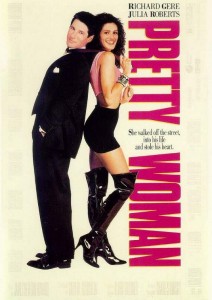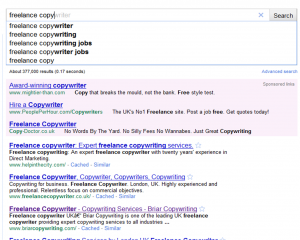Entries from September 2010 ↓
September 29th, 2010 — copywriter, freelance copywriter, search engine optimisation, SEO copywriter, website copywriter
 Is there really any point in you having a website if…
Is there really any point in you having a website if…
The internet is the place to be!
You are no one these days if you don’t have a website, but don’t rush out and grab any old thing.
Your website should exist for one reason, and one reason only – to sell. If it doesn’t do that, it’s a very expensive electronic brochure.
As a copywriter, I’ve used this blog as a platform to inform and (hopefully) educate people in how to get the most out of their website. But there are still people who don’t seem to get it.
Your website is your online shop window. If you did happen to have a shop window you’d want it to be in full view of everyone, eye-catching, informative and enticing enough to make people walk into your shop.
So why is it that sometimes it all goes to pot when you try to replicate that in a digital format?
Below are 5 instances when your website isn’t worth the space it’s taking up on the internet.
1. No one can find you
You might think that just by getting a website you’ve made it. There will be a small army of internet surfers landing on your home page. Well, think again. If you haven’t invested in any search engine optimisation, you are not going to be found.
If you’ve spent a small fortune on a very groovy looking flash site, you are going to find it difficult to get noticed because ranking may be tough as Google can’t read flash in the same ways it does HTML.
If you haven’t bothered to optimise your titles or URL and if you haven’t bothered investing in good SEO Copywriting, you’re not going to be found.
Yes, you could pay a small fortune and go down the PPC route, but did you know that 85% of internet users will click on the organic rankings and not the sponsored links?
SEO pays.
2. It’s all about you
Guess what? I’ve said it numerous times (but there’s no harm in repeating myself – I’m getting to the age when it’s acceptable), your reader couldn’t give a toss about you; they want to know what you are going to do for them.
If your navigation reads like – ‘About Us’, ‘What we do’, ‘Our products’, ‘News’ – they aren’t going to stick around. Your website copywriting has to be about your reader; how your product will help them – think benefits.
3. Tell them where to go
Don’t hide your navigation in cunning and artistic graphics. You want people to read your website. You want people to contact you. You want people to buy. So make it easy for them.
Clear, simple navigation will make your website easy to use and welcoming. If you make it hard work, your reader isn’t going to stick around.
4. Stop following me!
I really, really hate those websites that have pop up boxes that chase you around the screen. You’ve probably seen them, they either try to force you to sign up for something or ask ‘Are you sure you want to leave’ – YES, I’M SURE.
They are incredibly irritating. In fact even more so than number 5…
5. Music and video
I have absolutely nothing against using music or video on your website – it can be very effective. But don’t have it on autoplay.
The last thing I want is either a very s-l-o-w loading website, one that suddenly bursts into song, or one that thinks I want to watch a very loud video.
Why you need to know this
Despite what you may be thinking right now, I am not the only person who thinks this way.
When having your website designed, put your own ego and wishes to one side for a moment and think about what your customers want. After all, it will be selling to them.
So in summary:
• Get a website that is easily navigable
• Optimise your titles and URL
• Make sure your on page SEO (e.g. SEO copywriting) is done by a professional to boost your ranking possibilities
• Put an SEO strategy in place
• Make sure your website addresses your reader and sells them the benefits of your product
• Resist the urge for annoying gadgets no matter how ‘cool’ you might think they are
September 27th, 2010 — case studies, copywriter, freelance copywriter, marketing
 In any sales relationship, trust is probably the most important factor. Without trust, you are unlikely to make a sale.
In any sales relationship, trust is probably the most important factor. Without trust, you are unlikely to make a sale.
Therefore when producing copywriting for any marketing collateral you have to be able to convey trust.
If you blog, you’re laying your soul bare for all to read. Your posts are very personal so your reader feels as though they know you through your words. And it is that connection you have to try to replicate in your sales writing.
Too often you see dire sales letters – they’re full of hype and practically shout at the reader BUY MY PRODUCT NOW!
So it’s not surprising when they don’t yield great results.
People have a natural resistance to buying. You are asking them to part with their money so you have to show them you’re not a charlatan and you’re not going to rip them off. You have to convince them to trust you – not something that’s easy to do through text.
To help you get your sales message across in a non-shouty and threatening way, why not try one of these three techniques?
Tell them a story
If you want to tell someone about a product you are selling, don’t rely on bold or colourful lettering, just tell them about it.
Using the tried and tested story telling style will help you build credibility in the eyes of your reader. Tell them why you created the product weaving in your credentials (number of years experience, clients you’ve helped etc.) to your benefits driven copy.
This approach will help you get your benefits in first to instantly start to break down their buying resistance. Plus, mention of your experience, clients and motivations will help convince them you’re genuine.
It was all a mistake
If you happened upon the idea for your product or you were involved in doing something that others wanted to be part of, telling your reader that your service/product evolved by chance will show them the thought process behind your product, how it has helped others and – well, if they thought it was great, it must be.
Of course your story has to be true and credible if it’s going to work. This approach is an excellent way to make a human connection with your reader.
This is one of the most powerful sales tools there is. Writing about a client’s experience of your product/service will show the reader exactly what can be achieved. As with the other techniques this has to be based on fact and written with your client’s permission.
Name names, show quantifiable results and use direct quotes from your customer to add weight to it.
This type of real life illustration will really resonate with your reader.
As you can see, selling is about showing the benefits, breaking down resistance and convincing them to buy.
Once you’ve put your ‘sales pitch’ across don’t forget to add in your call to action.
Sally Ormond – freelance copywriter
September 24th, 2010 — copywriter, freelance copywriter, marketing, online marketing
Wouldn’t it be cool if you could produce a piece of marketing collateral that will promote your business forever?
Do you think that’s impossible?
Think again, not only is it possible, it’s something that many people are already doing. They just don’t realise it.
The legacy of online marketing
In the past, most of your marketing materials would have been off line – things like brochures, leaflets, magazine adverts and direct sales letters. The main problems with these are:
- They only reach a limited audience
As soon as your brochure is binned, the magazine has been read or your sales letter shredded, their contents are lost forever.
But if you market online, the beauty of the internet means your collateral is there forever. If you create it so it’s SEO friendly, it will continue to attract an audience for eternity – or at least for as long as it remains on the internet.
Imagine the power of that.
Using SEO techniques your blog posts, articles and web pages will draw new readers like a magnet. So are you making the most of it?
Boost your online presence
Take a look through your computer files. What information do you have that you’d forgotten about? I’m willing to bet you’ve an untapped gold mine of suitable marketing material just waiting to be uploaded onto the web.
It could be turned into articles, blog posts and even web pages. You’re bound to be harbouring a small flotilla of PDF files that could be utilised. But rather than simply adding them in their present form to your website, restructure the information into HTML web pages. The reason for this is a PDF has limited SEO abilities whereas changing into an HTML format will give you countless more opportunities to exploit SEO.
Why you need to know this
Online marketing is all about owning as much of the web as possible. Writing articles and blog posts not only provide you with valuable back links it also exposes your company to a vast, eternal audience.
Sally Ormond – freelance copywriter
September 22nd, 2010 — blogging, blogging for business, copywriter, freelance copywriter

After watching Pretty Woman for the umpteenth time the other day, one line hit me – in the scene where Julia Roberts struts her way over to Richard Gere’s car, her room mate Kit De Luca shouts: “Work it. Work it, baby. Work it. Work it. Own it.”
Well, that’s the only way you’re going to make a ripple in the pool of blogging – by working at your structure and presentation.
Writing a good bog isn’t just about having an idea and running with it. Of course, great ideas are important but so is how you execute them to produce informative, well written posts that people are going to want to read.
I’ve been blogging for several years now. Coming up with a fresh batch of ideas is tough, but inspiration can come from anywhere – films (like above), conversations, letters, images, experiences etc.
So what do you do when you’ve got an idea?
How to shape a great blog post
As I see it, there are five main steps you have to go through to create a great blog. It’s a system that works for me; this is how it goes:
1. Title
The title of your post is really important. It has to grab the attention of your reader – if it doesn’t they aren’t going to bother wasting any time over it. The best titles are ones that are very specific. Tell them what your post is about.
2. A great beginning
Many people think a blog is just about writing. I would disagree with that which is why all my posts are preceded by an image. Using an image that is related to your post in some way introduces an instant link in your reader’s mind. But not only that, the beginning of your post must grab them immediately.
You can either dive straight in or, like this post, begin with a personal experience. But if you do, make sure you also explain what it has to do with your subject matter.
As with any form of writing, the initial paragraph or two is what will make or break your post. Make it interesting and your reader will stay with you until the end.
3. Importance first
Pick the most important aspect that you are talking about and tackle it first. Explain concepts simply to your reader using simple terms and sentence structures. If you bamboozle them with jargon they’ll lose interest and go.
If your subject has more than one point, repeat this stage again until all your points are covered.
4. Tell them what to do
There’s no point in writing about a concept and then not telling them how they can put it into action. Give an example of how it can work for them. Take this post for example; if you’re still reading it you’re learning how you can utilise these techniques on your own blog.
5. Summarise
At the end of your post tell them why the information they’ve just read is relevant to them. Explain that when they put your tips into practice they will enhance their lives.
So as you can see. Being careful about how you create your posts paying attention to the heading, images and initial paragraph will help you write informative and enjoyable blog posts that people will want to read.
September 20th, 2010 — copywriter, Google Instant, seo
 I’m sure you’ve noticed by now that Google has been making a few changes to its search facility.
I’m sure you’ve noticed by now that Google has been making a few changes to its search facility.
Google Instant is here!
Now, when you make a search, Google predicts what you’re searching for. Once you see your search term appear in the box (as you can see below Google predicted I was searching for a freelance copywriter) results are automatically shown and change instantly depending on how your search term develops:

There have been numerous posts and news articles written about this new phenomena and what it is going to mean to users.
Rather than going over old ground, I wanted to being one of the best posts to your attention to illustrate precisely what Google Instant is going to mean to search engine optimisation.
If you haven’t already seen it, here’s a link to SEOBook.com’s post – How Google Instant Changes the SEO Landscape.
There are a couple of videos embeded within the post which are really good – one is quite long though so it may be best to save that one for your coffee break.
 Is there really any point in you having a website if…
Is there really any point in you having a website if… In any sales relationship, trust is probably the most important factor. Without trust, you are unlikely to make a sale.
In any sales relationship, trust is probably the most important factor. Without trust, you are unlikely to make a sale.
 I’m sure you’ve noticed by now that Google has been making a few changes to its search facility.
I’m sure you’ve noticed by now that Google has been making a few changes to its search facility.





